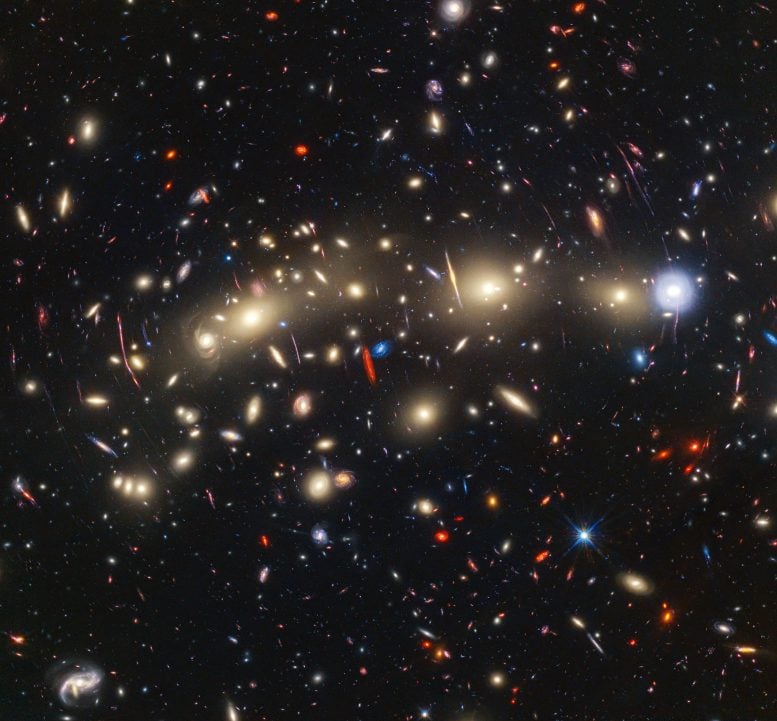
This panchromatic view of galaxy cluster MACS0416 was created by combining infrared observations from NASA’s James Webb Space Telescope with visible-light data from NASA’s Hubble Space Telescope. Credit: NASA, ESA, CSA, STScI, Jose M. Diego (IFCA), Jordan C. J. D’Silva (UWA), Anton M. Koekemoer (STScI), Jake Summers (ASU), Rogier Windhorst (ASU), Haojing Yan (University of Missouri)
The result: A vivid landscape of galaxies along with more than a dozen newfound, time-varying objects.
When two flagship observatories unite, they reveal a wealth of new details only possible through their combined power. Webb and Hubble have joined forces to study the galaxy cluster MACS0416, located about 4.3 billion light-years from Earth. Their combined data yields a prismatic panorama of blues and reds – colors that give clues to the distances of the galaxies. While the image itself is stunning, researchers are already using these observations to fuel new scientific discoveries, including the identification of gravitationally magnified supernovae and otherwise-invisible, ordinary stars.
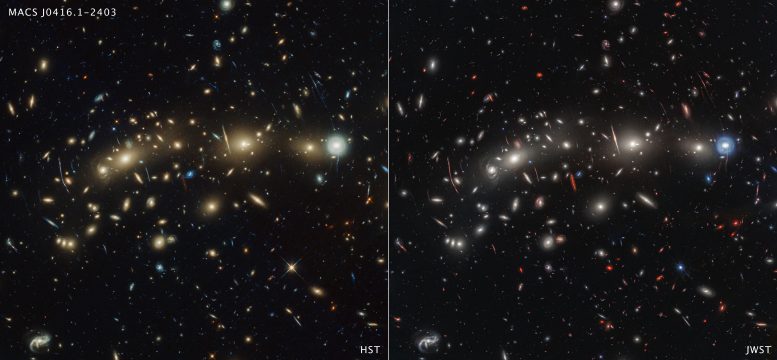
This side-by-side comparison of galaxy cluster MACS0416 as seen by the Hubble Space Telescope in optical light (left) and the James Webb Space Telescope in infrared light (right) reveals different details. Both images feature hundreds of galaxies, however, the Webb image shows galaxies that are invisible or only barely visible in the Hubble image. This is because Webb’s infrared vision can detect galaxies too distant or dusty for Hubble to see. (Light from distant galaxies is redshifted due to the expansion of the universe.) The total exposure time for Webb was about 22 hours, compared to 122 hours of exposure time for the Hubble image. Credit: NASA, ESA, CSA, STScI
NASA’s Webb and Hubble Space Telescopes Combine to Create Most Colorful View of Universe
NASA’s James Webb Space Telescope and Hubble Space Telescope have united to study an expansive galaxy cluster known as MACS0416. The resulting panchromatic image combines visible and infrared light to assemble one of the most comprehensive views of the universe ever taken. Located about 4.3 billion light-years from Earth, MACS0416 is a pair of colliding galaxy clusters that will eventually combine to form an even bigger cluster.
Details Revealed by Combined Telescopic Power
The image reveals a wealth of details that are only possible by combining the power of both space telescopes. It includes a bounty of galaxies outside the cluster and a sprinkling of sources that vary over time, likely due to gravitational lensing – the distortion and amplification of light from distant background sources.
This cluster was the first of a set of unprecedented, super-deep views of the universe from an ambitious, collaborative Hubble program called the Frontier Fields, inaugurated in 2014. Hubble pioneered the search for some of the intrinsically faintest and youngest galaxies ever detected. Webb’s infrared view significantly bolsters this deep look by going even farther into the early universe with its infrared vision.
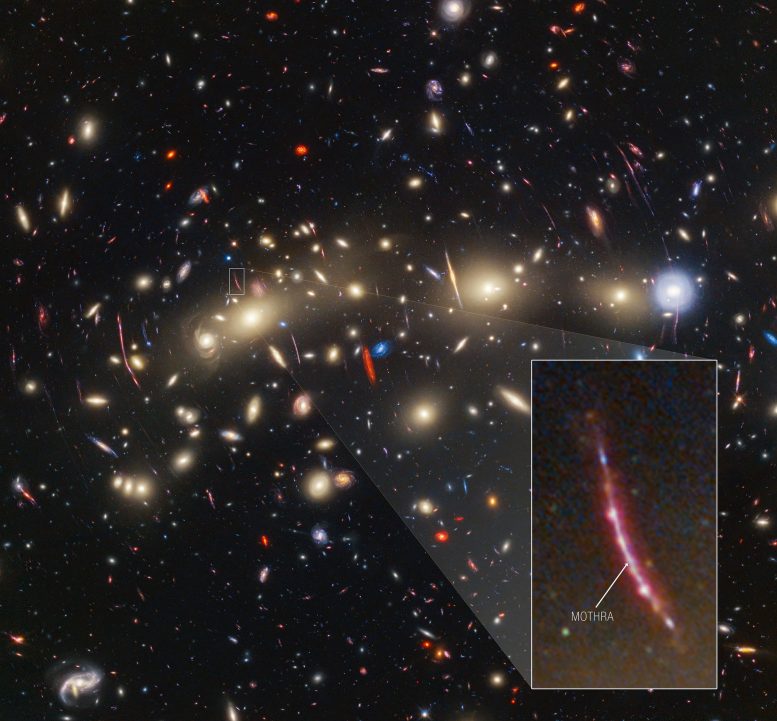
This image of galaxy cluster MACS0416 highlights one particular gravitationally lensed background galaxy, which existed about 3 billion years after the Big Bang. That galaxy contains a transient, or object that varies in observed brightness over time, that the science team nicknamed “Mothra.” Mothra is a star that is magnified by a factor of at least 4,000 times. The team believes that Mothra is magnified not only by the gravity of galaxy cluster MACS0416, but also by an object known as a “milli-lens” that likely weighs about as much as a globular star cluster. Credit: NASA, ESA, CSA, STScI, Jose M. Diego (IFCA), Jordan C. J. D’Silva (UWA), Anton M. Koekemoer (STScI), Jake Summers (ASU), Rogier Windhorst (ASU), Haojing Yan (University of Missouri)
“We are building on Hubble’s legacy by pushing to greater distances and fainter objects,” said Rogier Windhorst of Arizona State University, principal investigator of the PEARLS program (Prime Extragalactic Areas for Reionization and Lensing Science), which took the Webb observations.
Understanding the Image Colors and Scientific Goals
To make the image, in general, the shortest wavelengths of light were color-coded blue, the longest wavelengths red, and intermediate wavelengths green. The broad range of wavelengths, from 0.4 to 5 microns, yields a particularly vivid landscape of galaxies.
Those colors give clues to galaxy distances: The bluest galaxies are relatively nearby and often show intense star formation, as best detected by Hubble, while the redder galaxies tend to be more distant as detected by Webb. Some galaxies also appear very red because they contain copious amounts of cosmic dust that tends to absorb bluer colors of starlight.
“The whole picture doesn’t become clear until you combine Webb data with Hubble data,” said Windhorst.
Scientific Findings and the ‘Christmas Tree Galaxy Cluster’
While the new Webb observations contribute to this aesthetic view, they were taken for a specific scientific purpose. The research team combined their three epochs of observations, each taken weeks apart, with a fourth epoch from the CANUCS (CAnadian NIRISS Unbiased Cluster Survey) research team. The goal was to search for objects varying in observed brightness over time, known as transients.
They identified 14 such transients across the field of view. Twelve of those transients were located in three galaxies that are highly magnified by gravitational lensing, and are likely to be individual stars or multiple-star systems that are briefly very highly magnified. The remaining two transients are within more moderately magnified background galaxies and are likely to be supernovae.
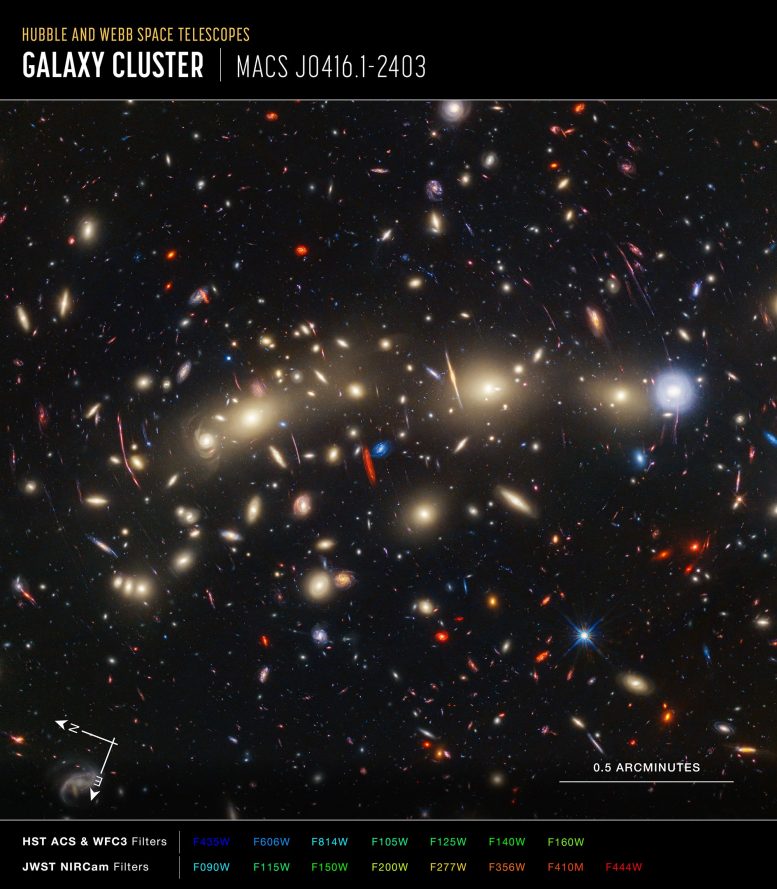
Image of galaxy cluster MACS0416 captured in visible light by Hubble’s ACS and WFC3 and in infrared light by Webb’s NIRCam, with compass arrows, scale bar, and color key for reference.
The north and east compass arrows show the orientation of the image on the sky. Note that the relationship between north and east on the sky (as seen from below) is flipped relative to direction arrows on a map of the ground (as seen from above).
The scale bar is labeled in arcminutes, which is an angle on the sky equivalent to one-60th of a degree. (The scale bar is half an arcminute long.) The full image is approximately 2.2 acrminutes across.
This image shows visible and near-infrared wavelengths of light that have been translated into colors. The color key shows which Hubble ACS and WFC3 and Webb NIRCam filters were used when collecting the light. The color of each filter name is the visible light color used to represent the light that passes through that filter.
Credit: NASA, ESA, CSA, STScI, Jose M. Diego (IFCA), Jordan C. J. D’Silva (UWA), Anton M. Koekemoer (STScI), Jake Summers (ASU), Rogier Windhorst (ASU), Haojing Yan (University of Missouri)
“We’re calling MACS0416 the Christmas Tree Galaxy Cluster, both because it’s so colorful and because of these flickering lights we find within it. We can see transients everywhere,” said Haojing Yan of the University of Missouri in Columbia, lead author of one paper describing the scientific results.
Finding so many transients with observations spanning a relatively short time frame suggests that astronomers could find many additional transients in this cluster and others like it through regular monitoring with Webb.
Discovery of a Unique Transient: ‘Mothra’
Among the transients the team identified, one stood out in particular. Located in a galaxy that existed about 3 billion years after the Big Bang, it is magnified by a factor of at least 4,000. The team nicknamed the star system “Mothra” in a nod to its “monster nature,” being both extremely bright and extremely magnified. It joins another lensed star the researchers previously identified that they nicknamed “Godzilla.” (Both Godzilla and Mothra are giant monsters known as kaiju in Japanese cinema.)
Interestingly, Mothra is also visible in the Hubble observations that were taken nine years previously. This is unusual, because a very specific alignment between the foreground galaxy cluster and the background star is needed to magnify a star so greatly. The mutual motions of the star and the cluster should have eventually eliminated that alignment.
The most likely explanation is that there is an additional object within the foreground cluster that is adding more magnification. The team was able to constrain its mass to be between 10,000 and 1 million times the mass of our Sun. The exact nature of this so-called “milli-lens,” however, remains unknown.
“The most likely explanation is a globular star cluster that’s too faint for Webb to see directly,” stated Jose Diego of the Instituto de Física de Cantabria in Spain, lead author of the paper detailing the finding. “But we don’t know the true nature of this additional lens yet.”
The Yan et al. paper is accepted for publication in The Astrophysical Journal. The Diego et al. paper has been published in Astronomy & Astrophysics.
The Webb data shown here were obtained as part of PEARLS GTO program 1176.
For more on this research:
References:
“JWST’s PEARLS: Transients in the MACS J0416.1-2403 Field” by Haojing Yan, Zhiyuan Ma, Bangzheng Sun, Lifan Wang, Patrick Kelly, Jose M. Diego, Seth H. Cohen, Rogier A. Windhorst, Rolf A. Jansen, Norman A. Grogin, John F. Beacom, Christopher J. Conselice, Simon P. Driver, Brenda Frye, Dan Coe, Madeline A. Marshall, Anton Koekemoer, Christopher N. A. Willmer, Aaron Robotham, Jordan C. J. D’Silva, Jake Summers, Mario Nonino, Nor Pirzkal, Russell E. Ryan Jr., Rafael Ortiz III, Scott Tompkins, Rachana A. Bhatawdekar, Cheng Cheng, Adi Zitrin and S. P. Willner, Accepted, The Astrophysical Journal.
arXiv:2307.07579
Reference: “JWST’s PEARLS: Mothra, a new kaiju star at z = 2.091 extremely magnified by MACS0416, and implications for dark matter models” by Jose M. Diego, Bangzheng Sun, Haojing Yan, Lukas J. Furtak, Erik Zackrisson, Liang Dai, Patrick Kelly, Mario Nonino, Nathan Adams, Ashish K. Meena, Steven P. Willner, Adi Zitrin, Seth H. Cohen, Jordan C. J. D’Silva, Rolf A. Jansen, Jake Summers, Rogier A. Windhorst, Dan Coe, Christopher J. Conselice, Simon P. Driver, Brenda Frye, Norman A. Grogin, Anton M. Koekemoer, Madeline A. Marshall, Nor Pirzkal, Aaron Robotham, Michael J. Rutkowski, Russell E. Ryan, Scott Tompkins, Christopher N. A. Willmer and Rachana Bhatawdekar, 1 November 2023, Astronomy & Astrophysics.
DOI: 10.1051/0004-6361/202347556
The James Webb Space Telescope is the world’s premier space science observatory. Webb is solving mysteries in our solar system, looking beyond to distant worlds around other stars, and probing the mysterious structures and origins of our universe and our place in it. Webb is an international program led by NASA with its partners, ESA (European Space Agency) and the Canadian Space Agency.
The Hubble Space Telescope is a project of international cooperation between NASA and ESA. NASA’s Goddard Space Flight Center in Greenbelt, Maryland, manages the telescope. The Space Telescope Science Institute (STScI) in Baltimore, Maryland, conducts Hubble and Webb science operations. STScI is operated for NASA by the Association of Universities for Research in Astronomy, in Washington, D.C.

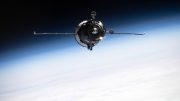


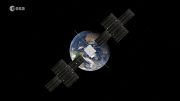


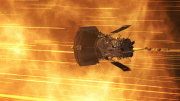
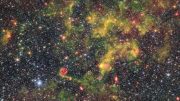
If the Universe is expanding, colliding galaxies makes no sense. You tweaked my BS meter.